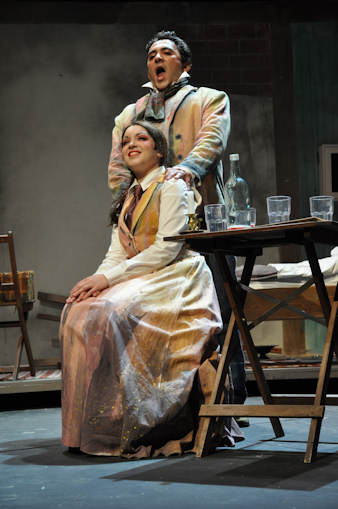Other Links
Editorial Board
- Editor - Bill Kenny
Assistant Webmaster -Stan Metzger - Founder - Len Mullenger
Google Site Search
SEEN AND HEARD
INTERNATIONAL OPERA REVIEW
Opera på Skäret 2010 - Puccini, La bohème (Premiere) : Soloists, Bergslagens musikdramatiska kör, La Bohème orkestern / Andreas Lönnqvist, Opera på Skäret, Kopparberg, Sweden, 31.7.2010 (GF) Set design by Sven Östberg Costume design by Sigyn Stenqvist Lighting design by Ronny Andersson Choreography by Per-Birger Stenudd Yana Kleyn – Mimì César Augusto Gutiérrez – Rodolfo Peter Kajlinger – Marcello Catarina Lundgren – Musetta Bo Rosenkull – Schaunard Sami Yousri – Colline Mikael Axelsson – Alcindoro, Benoit Jonatan Lönnqvist – Parpignol Peter Haeggström – Waiter
It is a colourful Paris that Sven Östberg has created for this year’s production of La bohème at Opera på Skäret. It takes place somewhere around the previous turn of the century, i.e. roughly the time when Puccini created his masterpiece, and omnipresent during the four acts, is the façade and/or interior of Theatre Latin. This is the work place for the four Bohemians who write, compose, paint and act there. When we meet them in the cold and rather forbidding attic, the theatre is closed, but still they stick to their ideals, their devotion to art in its various forms. According to Östberg’s notes in the programme book, the philosophy behind the production is Ludwig Feuerbach’s thesis that ‘you are what you eat’. In other words, these theatre workers see the world as a theatre performance, in this case a badly rehearsed one. One clear source of inspiration for the sets and the Bohemians’ costumes is the paintings by Henri Toulouse-Lautrec. The rest of the people, on the other hand, are not painted. They are white with sketchy features.
During previous seasons, Skäret have engaged permanent orchestras but this year’s La Bohème Orchestra is a pick-up group consisting of eminently excellent musicians. I only wish there could have been room for a few more string players – as it is there are only four first violins – to give full justice to Puccini’s lush string melodies but with the means available Andreas Lönnqvist and his forces provide an admirable backbone to the singing and the acoustics of the large wooden building make them sound bigger than they actually are. The chorus, primarily essential in the second act, is also a pick-up group, having rehearsed several weekends during the spring term to be prepared for the final rehearsals during July. They are truly unanimous and are no mean actors.
Directed by Alexander Niclasson
Cast

Yana Kleyn – Mimì and César Augusto Gutiérrez – Rodolfo
The conceptual ideas apart, this is largely a traditional production, tightly knit together. So much so in fact that the first two acts are played attacca. With the relatively limited technical resources at Skäret, focus is very much on the central characters and the interplay between them – rightly so since this is a relational drama. Alexander Niclasson has endeavoured to inspire the singers to act with psychological realism in gestures, postures and facial expressions. The elements of comedy in the first two acts as well as the opening of Act IV are well taken care of and rarely has the Bohemians’ attic been so bitingly chilly or the inhabitants so genuinely frozen. The second act at Café Momus, which here is an outdoor establishment in the open space in front of Theatre Latin, is properly crowded and there are several individually chiselled characters, not least the rather haughty head waiter.
But the core of this opera is the love and conflict between Mimì and Rodolfo and it is sensitively and tenderly depicted. Their first meeting, a little awkward to begin with, gradually develops into true passion in the love duet and the Café Momus scene puts their incipient love in sharp relief to the burlesqueries in the domestic triangle Musetta – Alcindoro – Marcello. Once the mock-jealousy in the third act is over, the warmth between the lovers is again to the fore and the protracted death-scene is immensely moving and humane. Overall, the acting is excellent and it may be unfair to give a special mention of Miikael Axelsson’s dual portraits of Benoit – he is in this production Chinese and his real name is Bee-Noh-Aah – and the neurotic Alcindoro, as well as Bo Rosenkull’s clear-cut Schaunard, who here for once is a true personality.

The Opera på Skäret Theatre
The central couple, Rodolfo and Mimì, also carry the main burden vocally. The young Russian Yana Kleyn, here making her international debut, has the ideal looks for the little seamstress and gave a captivating portrait of Mimi. Her bright soprano has a slightly metallic edge but also great warmth and her two great solos in the last two acts, Donde lieta usci and Sono andati were not only brilliantly executed but utterly finely nuanced. She seems cut out for a great career. César Augusto Gutierrez, on the other hand, has already been around for many years and is well established in many important opera houses. Brilliance and power combined with fine sense for nuance also characterize his singing. During the first half of the opera he tended to force unnecessarily but his singing in the last two acts showed him on top form. Peter Kajlinger, whose Rigoletto in Karlstad last year was a strong achievement, again proved that he is one of the best Scandinavian baritones and Catarina Lundgren was a good Musetta. Colline is not a big role but he has one of the finest arias in the opera, the farewell to his coat, and Sami Yousri sang it with restraint, warmth and beautiful legato.
The premiere was sold out and advance sales have generally been very good but there are still chances to see this La Bohème, which is running until 22nd August. And, for those who still haven’t visited Skäret, the location and the house in itself are truly charming and exotic. Just imagine: this is the only opera house in the world with its own railway station!
Göran Forsling
Photo © Aulis Syväjärvi
